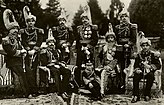
Back রাণা বংশ Bengali/Bangla Dinastía Rana Spanish Ranade dünastia Estonian રાણા વંશ Gujarati राणा वंश Hindi Dinasti Rana ID Rana (famiglia) Italian ラナ家 Japanese राणा वंश MAI राणा वंश Nepali
This article needs additional citations for verification. (September 2011) |
| Rana dynasty राणा वंश Ranas of Nepal | |
|---|---|
 | |
 | |
| Parent family | Kunwar family |
| Country | Kingdom of Nepal |
| Founded | 1846 |
| Founder | Bir Narsingh Kunwar (Jung Bahadur Rana) |
| Current head | Pashupati Shumsher Rana |
| Final ruler | Mohan Shumsher Rana |
| Titles | Shree Teen Maharaja of Nepal, Maharaja of Lamjung and Kaski |
| Motto | |
| Properties | Rana palaces of Nepal |
| Dissolution | 1951 |
| Rana Dynasty 1846–1951 CE | ||||||||||||||||||||||
|---|---|---|---|---|---|---|---|---|---|---|---|---|---|---|---|---|---|---|---|---|---|---|
|
||||||||||||||||||||||
The Rana dynasty (Nepali: राणा वंश Sanskrit: [raːɳaː ʋɐ̃ɕɐ], Nepali: [raɳa bʌŋsʌ]) was a Chhetri[note 1] dynasty that[6] imposed authoritarianism in the Kingdom of Nepal from 1846 until 1951, reducing the Shah monarch to a figurehead and making the Prime Minister and other government positions held by the Ranas hereditary. The Rana dynasty is historically known for their iron-fisted rule in Nepal.[7] This changed after the Revolution of 1951 with the promulgation of a new constitution, when power shifted back to the monarchy of King Tribhuvan.[8]
The Rana dynasty were descended from the Kunwar family, a nobility of the Gorkha Kingdom.[9] Due to their marital lineages with the politically reigning Thapa dynasty (of Mukhtiyar Bhimsen Thapa) from the early 19th century, the Ranas gained entry to central Darbar politics.[10][5] The Ranas were also linked to a minor faction of the Pande dynasty of Gorkha through the Thapa dynasty.[5]
- ^ Dor Bahadur Bista 1991, p. 37.
- ^ Sharma Baral 1964, p. 111.
- ^ Regmi 1975, p. 90.
- ^ Wright 1877, p. 285.
- ^ a b c Cite error: The named reference
PurushottamShamsher1990was invoked but never defined (see the help page). - ^ Van PraaghD (2003). Greater Game. MQUP. p. 319. ISBN 978-0-7735-7130-3. Archived from the original on 11 September 2017. Retrieved 11 September 2017.
- ^ "The Rana reign | Nepali Times Buzz | Nepali Times".
- ^ Kraemer, Karl-Heinz. "Democratization and political parties in Nepal". Harvard University. Archived from the original on 24 May 2013. Retrieved 25 November 2012.
- ^ Joshi & Rose 1966, p. 30.
- ^ Acharya 2012, p. 11-12.
Cite error: There are <ref group=note> tags on this page, but the references will not show without a {{reflist|group=note}} template (see the help page).

